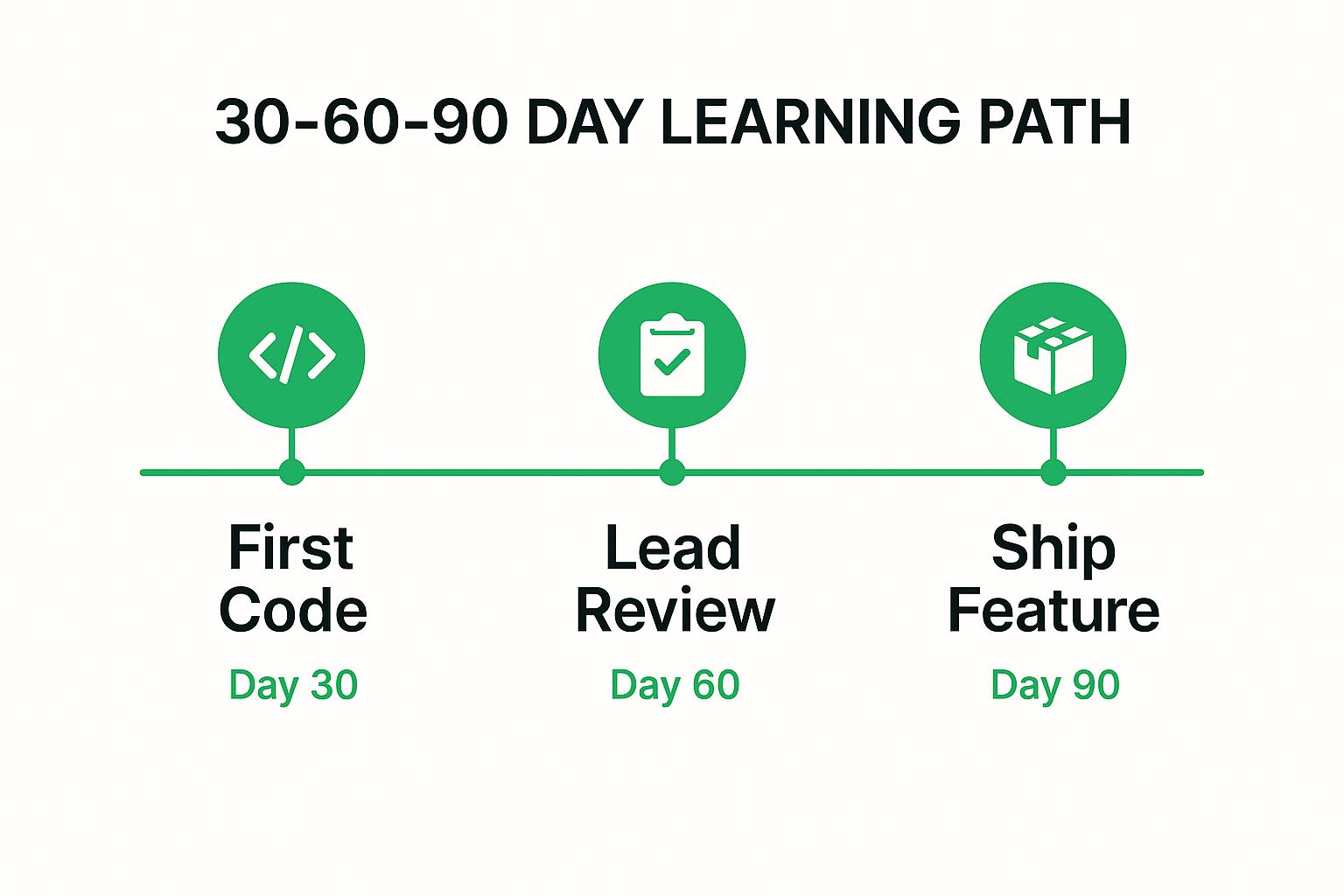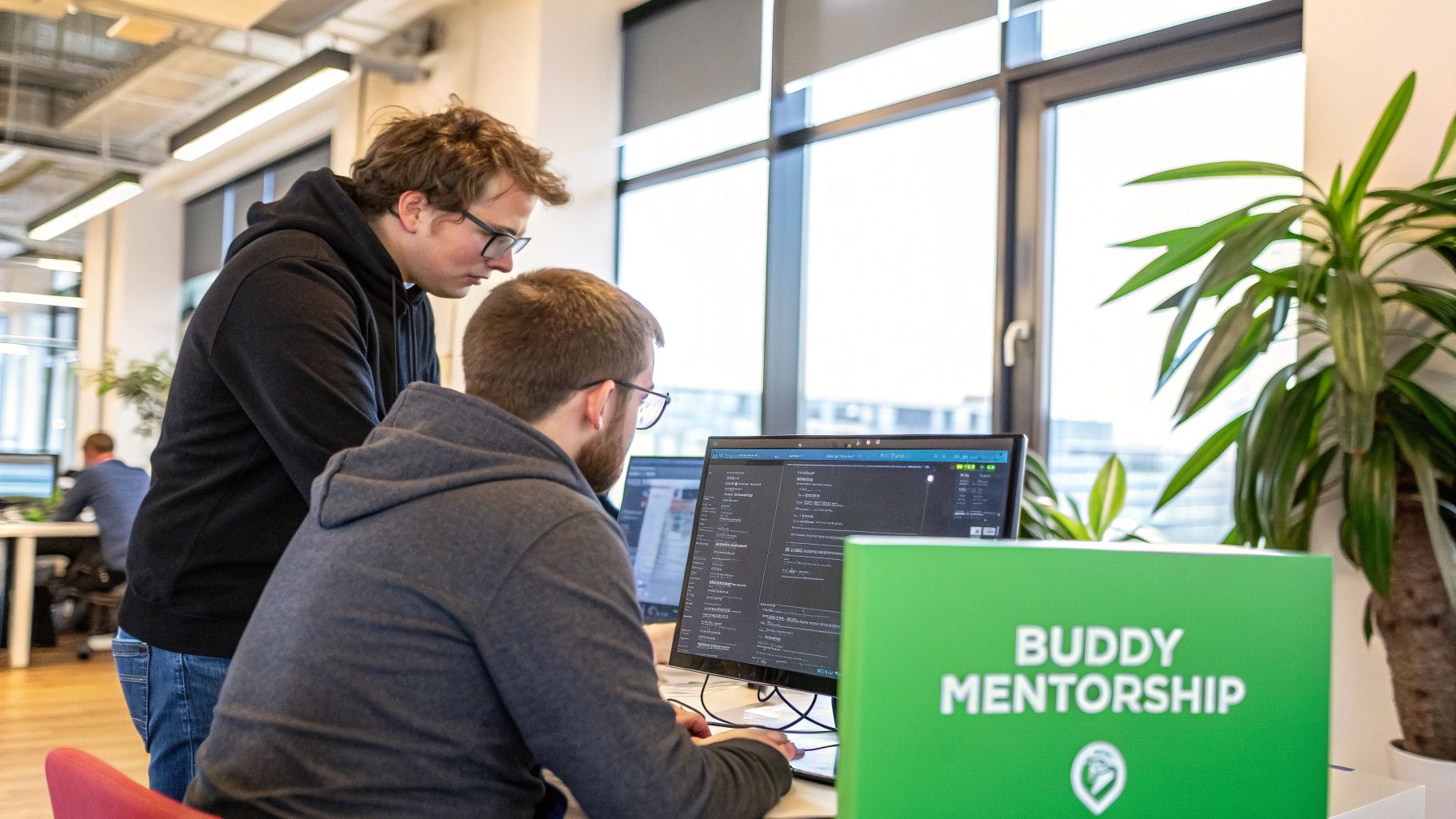Discover 8 developer onboarding best practices to streamline integration, boost productivity, and improve retention. Master your process with our 2025 guide.
Onboarding a new developer is more than just a first-day orientation; it’s a critical, extended process that dictates their future productivity, engagement, and retention. A disjointed or confusing onboarding experience can lead to early attrition and slow ramp-up times, costing organizations significant resources. Conversely, a well-structured program accelerates a new hire’s journey from a newcomer to a confident, high-impact contributor. The challenge lies in moving beyond generic welcome packets and creating a systematic, repeatable, and human-centric process.
This article will explore eight essential developer onboarding best practices that top engineering teams use to build effective, integrated members. We will break down each practice into actionable steps, supported by real-world examples and data-driven insights, providing a comprehensive blueprint for optimizing how you welcome new talent. By implementing these strategies, you can transform your onboarding from a mere administrative task into a powerful strategic advantage. You will learn precisely how to prepare for new hires, structure their initial months, provide meaningful support, and foster an environment where they can thrive technically and culturally.
The onboarding process doesn’t start on a developer’s first day; it begins the moment they accept the job offer. Pre-boarding is the critical, proactive phase of preparing all necessary tools, accounts, and resources before a new hire walks through the door (virtual or physical). This practice is a cornerstone of effective developer onboarding best practices because it eliminates the frustrating and unproductive delays that plague a new developer’s initial days, such as waiting for access permissions, hardware, or software licenses.

Effective pre-boarding transforms a potentially anxious first day into an engaging and productive one. For example, GitLab creates a comprehensive onboarding issue in their system for each new hire well before their start date. This issue acts as a master checklist, tracking everything from HR paperwork to the creation of accounts for dozens of systems, ensuring all access is granted and verified beforehand. Similarly, Stripe is known for shipping pre-configured laptops directly to new hires, allowing them to log in and find their development environment ready to go.
Pre-boarding immediately signals that your organization is efficient, values the new developer’s time, and is invested in their success from day one. It sets a positive tone for their entire tenure. The primary benefit is the immediate removal of blockers, allowing new engineers to start contributing, learning the codebase, and integrating with their team much faster. This not only accelerates their time-to-productivity but also significantly boosts their initial morale and sense of belonging.
To implement a successful pre-boarding strategy, focus on systematic coordination:
A successful developer onboarding process is not a sprint; it’s a marathon with clear milestones. Implementing a structured 30-60-90 day learning path is a powerful developer onboarding best practice that provides a progressive framework for growth. This approach breaks the overwhelming initial period into three distinct, manageable phases. Each phase comes with specific goals, learning objectives, and performance expectations, guiding a new developer from initial code exposure to confident, autonomous contribution.
This timeline visualizes a sample progression, with milestones set for shipping initial code, leading code reviews, and ultimately, shipping a significant feature.
The plan provides a clear trajectory from foundational tasks to high-impact contributions, aligning expectations for both the new hire and the team. For example, HubSpot implements graduated responsibility levels with specific coding challenges at each milestone, while Atlassian sets a goal for developers to ship their first code in week one, contribute to a major feature by day 30, and lead a small project by day 90. This phased approach prevents cognitive overload and fosters a sense of accomplishment.

A 30-60-90 day plan replaces ambiguity with clarity. It answers the new hire’s unspoken question: “What does success look like here?” By setting incremental goals, it prevents them from feeling lost or unproductive. This structure provides a clear roadmap for both technical and cultural integration. The primary benefit is that it establishes a predictable and measurable path to full productivity, empowering developers to take ownership of their learning journey while giving managers a concrete framework for providing feedback and support.
To effectively implement a 30-60-90 day plan, focus on customization and communication:
A robust buddy system or mentorship program pairs new developers with experienced team members who serve as their primary point of contact, cultural guide, and technical mentor during the initial weeks or months. This practice establishes a safe, one-on-one channel for asking questions that a new hire might feel are too “basic” for a group setting. It provides personalized support that formal documentation and training sessions simply cannot replicate, directly addressing one of the most common hurdles in developer onboarding: navigating unwritten rules and complex technical landscapes.

This approach has been successfully institutionalized by top tech companies. For instance, Google’s famous “Noogler” program pairs new engineers with volunteers who guide them on everything from technical queries to company culture. Similarly, Meta (formerly Facebook) implements a buddy system that includes weekly coffee chats and collaborative work on initial tasks, ensuring the new hire feels connected and supported. Airbnb takes this further by assigning “Culture Champions” who specifically focus on helping new hires understand and integrate with the company’s core values and unique ways of working.
A dedicated buddy or mentor dramatically accelerates a new developer’s social and technical integration into the team. It provides a psychological safety net, encouraging them to seek help early and often, which prevents small misunderstandings from becoming major blockers. The key benefit is the humanization of the onboarding process, fostering a sense of belonging and camaraderie from day one. This personal connection is a powerful tool for improving retention, as it makes new hires feel valued and supported on a personal level, not just as a productive unit.
To implement a successful mentorship program, focus on structure and clear communication:
Passive learning, like reading documentation for days on end, is an inefficient and disengaging way to onboard new developers. Instead, the best practice is to immerse them in the codebase through hands-on, project-based learning. This approach involves assigning new engineers small but meaningful projects from their very first week, allowing them to learn the systems, tools, and team workflows through practical application rather than abstract theory.

This method accelerates learning and delivers tangible value. For example, Dropbox assigns new hires a “starter project” designed to touch multiple parts of the system and be completed within two to three weeks. Similarly, Netflix famously encourages new engineers to ship code to production within their first week, starting with small, low-risk changes under close supervision. This “first push” is a celebrated milestone that builds immediate confidence and a sense of contribution.
Project-based learning is a core component of modern developer onboarding best practices because it directly combats the “analysis paralysis” that comes from information overload. By working on a real task, developers learn what they need to know, when they need to know it. This context-driven learning is far more effective and memorable than passively consuming documentation. It provides early wins, demonstrates trust in the new hire’s abilities, and quickly integrates them into the team’s development lifecycle, including code reviews and deployment processes.
To effectively implement project-based learning, structure the experience carefully:
A new developer’s ability to learn and contribute independently is directly proportional to the quality of your documentation. A comprehensive and easily searchable knowledge base is a cornerstone of developer onboarding best practices. It serves as a single source of truth, covering everything from architectural diagrams and environment setup scripts to coding standards and team-specific rituals. This resource empowers new hires to find answers on their own, fostering autonomy and reducing interruptions to the senior team.
World-class organizations treat documentation as a product, not an afterthought. For instance, GitLab’s public handbook is a masterclass in transparency, with over 2,000 pages detailing company processes, values, and engineering practices. Similarly, Shopify enhances its internal documentation with interactive tutorials and video walkthroughs, catering to different learning styles. This approach transforms documentation from a static text file into a dynamic, self-service learning platform that accelerates a new developer’s integration.
Well-maintained documentation significantly reduces a new developer’s “time to first contribution.” It acts as a patient, always-available mentor that can answer common questions at any time, which is especially critical in remote or globally distributed teams. By providing a reliable reference, you build a culture of self-sufficiency and continuous learning. This not only frees up senior engineers from answering repetitive questions but also ensures that institutional knowledge is captured and retained, rather than lost to employee turnover. Beyond just technical documentation, providing essential company information is key. Consider resources like an employee handbook to guide new hires.
To build a knowledge base that accelerates rather than hinders, focus on accessibility and maintenance:
Throwing a new developer into a standard, high-stakes code review process on day one is a recipe for anxiety and slow progress. Instead, a gradual code review and feedback process introduces them to team standards and codebase conventions in a supportive, structured manner. This approach begins with intensive, hands-on guidance and progressively grants more autonomy as the developer’s competence and confidence grow. It’s a key developer onboarding best practice that transforms code review from a gatekeeping mechanism into a powerful teaching tool.
This method shifts the focus from purely catching errors to actively mentoring. For instance, Stack Overflow is known to use “learning reviews,” where senior developers provide extensive, explanatory comments on a new hire’s pull requests, explaining the reasoning behind suggestions. Similarly, Palantir uses a tiered system where new engineers initially have their code reviewed by senior architects to ensure foundational understanding, eventually graduating to standard peer reviews once they have demonstrated proficiency with the team’s patterns and practices.
A gradual review process accelerates a new developer’s learning curve by providing context-rich, actionable feedback at the most relevant moment: when they are actively working on code. It demystifies team standards, reduces the fear of making mistakes, and fosters a culture of psychological safety. This practice ensures that new hires don’t just learn what to change, but why the change is necessary, leading to deeper and more durable knowledge. The result is a faster ramp-up to producing high-quality, independent contributions and a stronger integration into the team’s engineering culture.
To effectively implement a gradual review process, create a clear, multi-stage plan:
Technical proficiency is only one part of a developer’s success; feeling connected to the team and aligned with the company’s mission is equally critical. Cultural integration involves deliberately designed activities and processes that help new developers understand company values, team dynamics, and unwritten social norms. This aspect of developer onboarding best practices ensures a new hire doesn’t just learn what to do, but also how and why things are done in a particular way, fostering a deeper sense of belonging and psychological safety.
A strong cultural fit can be the difference between a developer who stays for years and one who leaves within months. For instance, Zappos famously puts every new hire, including engineers, through extensive culture training that includes working in the customer service department to internalize their commitment to the customer. Similarly, Patagonia’s onboarding often includes outdoor activities that directly connect new employees to the company’s environmental mission, making the values tangible rather than just words on a wall.
Focusing on cultural integration accelerates the process of building trust and effective collaboration. A developer who understands the team’s communication style, decision-making processes, and shared values can integrate into workflows more seamlessly and contribute to discussions with greater confidence. This practice combats feelings of isolation, especially in remote or hybrid environments, and significantly improves long-term employee retention by making new hires feel like genuine members of the community, not just coders.
To effectively integrate a new developer into your team’s culture:
An onboarding program should never be static; it must evolve. Continuous feedback and iterative improvement is the practice of systematically gathering insights from new hires about their onboarding experience and using that data to refine the process. This transforms onboarding from a one-time event into a living, dynamic system that gets better with each new developer who joins. This approach is a critical developer onboarding best practice because it ensures your process remains relevant, effective, and addresses the real-world challenges new engineers face.
This practice is about creating a formal mechanism to listen and act. For example, LinkedIn implements a ‘New Hire Net Promoter Score’ (NPS) survey to gauge satisfaction and identifies key detractors to drive targeted improvements. Similarly, Twilio tracks detailed metrics like time-to-first-commit and time-to-productivity, A/B testing different onboarding flows to optimize these outcomes. Slack takes a qualitative approach, running quarterly retrospectives with recent hires to pinpoint specific friction points and brainstorm solutions.
Establishing a feedback loop demonstrates that your organization values its employees’ experiences and is committed to operational excellence. It prevents the onboarding process from becoming outdated or disconnected from the team’s current needs. The primary benefit is the creation of a highly optimized and developer-centric experience that accelerates learning, boosts long-term engagement, and reduces new hire attrition. By continuously iterating, you proactively solve problems for future hires, making each onboarding cycle more efficient than the last.
To build an iterative onboarding system, focus on structured data collection and action:
The journey from a new hire’s first day to their full integration is a direct reflection of your company’s culture, processes, and commitment to excellence. Moving beyond a simple checklist, the developer onboarding best practices we’ve explored serve as the architectural blueprint for building a resilient, high-performing engineering organization. This isn’t merely an HR function; it’s a core strategic initiative that directly impacts productivity, innovation, and long-term growth.